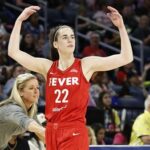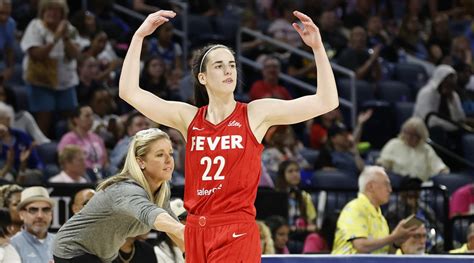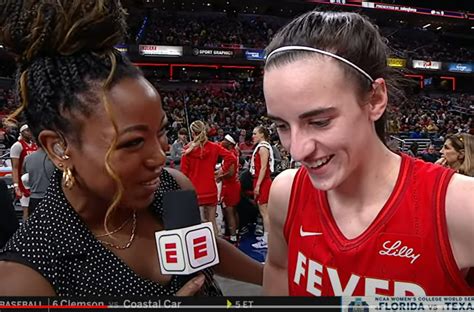
Mounting pressure on Caitlin Clark within the WNBA, stemming from perceived targeting and insufficient support from teammates, has ignited a debate about whether the rookie sensation should consider leaving the league to protect her long-term career and well-being.
The intense physicality and perceived animosity directed at Indiana Fever guard Caitlin Clark have fueled a growing chorus of voices suggesting she might be better off stepping away from the WNBA, at least temporarily. While such a move would be unprecedented for a player of Clark’s caliber so early in her career, the calls highlight concerns about her physical safety, the lack of adequate support from her teammates in addressing the aggressive play against her, and the potential long-term impact on her marketability and mental health.
The debate gained significant traction after a recent game against the Chicago Sky where Clark was on the receiving end of a hard foul by Sky guard Chennedy Carter. While Carter was ultimately assessed a Flagrant 1 foul, the incident sparked widespread discussion about whether Clark is being unfairly targeted due to her immense popularity and the attention she brings to the league. Some analysts and fans argue that veteran players are resentful of Clark’s immediate impact and are using excessive physicality to “teach her a lesson.”
Adding fuel to the fire is the perception that Clark’s teammates are not consistently stepping up to defend her when she is subjected to aggressive play. Critics point to a lack of collective response from the Fever players during and after incidents, suggesting a need for stronger on-court protection and public support for their star player. This perceived lack of support, coupled with the constant media scrutiny, has created a pressure cooker environment for Clark.
“There’s a growing push for Caitlin Clark to bail on the WNBA,” reported Yahoo Sports, echoing the sentiment of many who believe the current situation is unsustainable. The argument centers on the idea that Clark’s long-term prospects, both on and off the court, could be jeopardized if she continues to endure this level of physical and emotional stress.
The calls for Clark to consider leaving, while controversial, reflect a deep concern for her well-being and the integrity of the game. Supporters of this view argue that Clark’s value extends beyond her on-court performance, and that protecting her brand and mental health is paramount. This line of thinking suggests that a temporary departure could allow the WNBA to address the issues of player safety and competitive balance, ultimately creating a more supportive environment for Clark’s eventual return.
However, others vehemently oppose the idea of Clark leaving the WNBA. They argue that such a move would set a dangerous precedent, suggesting that players can simply opt out when faced with adversity. They also contend that Clark has a responsibility to her team, her fans, and the league to persevere through these challenges and help elevate the WNBA to new heights.
Moreover, some observers believe that Clark’s struggles are simply part of the adjustment process for any rookie entering a professional league. They point out that all players face physical challenges and competitive pressures, and that Clark will need to learn how to adapt and overcome these obstacles to succeed in the WNBA. They also highlight the importance of allowing the league and its players to self-regulate and address any issues of excessive physicality through internal channels.
The debate surrounding Caitlin Clark’s future in the WNBA underscores the complex dynamics at play within the league. It raises important questions about player safety, competitive balance, the role of star players, and the responsibility of teams and the league to protect their athletes. As Clark continues to navigate these challenges, her decisions will undoubtedly have a significant impact on the future of the WNBA and the perception of women’s basketball as a whole.
The situation also brings into focus the racial undertones that have subtly permeated the discourse surrounding Clark’s arrival in the WNBA. While overt racism is largely absent, some observers have noted a disparity in the treatment and media coverage of Clark compared to black players who have been in the league for years. This perceived imbalance has fueled resentment among some fans and players, contributing to the already tense atmosphere surrounding Clark’s presence in the WNBA.
Furthermore, the intense focus on Clark has inadvertently overshadowed the accomplishments and contributions of other talented players in the league. Some critics argue that the media’s obsession with Clark has created a narrative that minimizes the achievements of veteran players and diminishes the overall quality of the WNBA. This has led to accusations of preferential treatment and a perception that Clark is being elevated at the expense of other deserving athletes.
The WNBA finds itself at a critical juncture, facing the challenge of balancing the need to protect its star players with the desire to maintain a competitive and entertaining product. The league must take proactive steps to address the issues of player safety and competitive balance, while also fostering a more inclusive and supportive environment for all of its athletes. Failure to do so could have long-term consequences for the WNBA’s growth and popularity.
Ultimately, the decision of whether or not to remain in the WNBA rests with Caitlin Clark. She must weigh the potential benefits of staying and fighting through the challenges against the potential risks to her physical and mental health. Her choice will not only shape her own career but also influence the future of the WNBA and the perception of women’s basketball for years to come.
The debate surrounding Clark also highlights the changing landscape of women’s sports and the growing pressure on young athletes to perform at the highest level from a young age. Clark’s exceptional talent and early success have made her a target for both admiration and criticism, placing her under immense pressure to live up to the lofty expectations that have been placed upon her.
This pressure is further amplified by the increasing commercialization of women’s sports, which has created new opportunities for athletes to earn endorsements and build their personal brands. While these opportunities can be lucrative, they also come with added responsibilities and expectations. Athletes like Clark are not only expected to perform on the court but also to maintain a positive public image and engage with fans on social media.
The WNBA must recognize the unique challenges faced by young athletes like Clark and provide them with the resources and support they need to thrive both on and off the court. This includes providing access to mental health services, financial literacy training, and media relations support. The league must also work to create a culture that values player well-being and promotes a healthy balance between competition and personal life.
In addition to addressing the needs of individual players, the WNBA must also address the systemic issues that contribute to the challenges faced by athletes like Clark. This includes addressing issues of pay equity, improving player benefits, and promoting greater diversity and inclusion within the league’s leadership. The WNBA has made significant progress in recent years, but there is still much work to be done to create a truly equitable and supportive environment for all of its players.
The situation surrounding Caitlin Clark serves as a wake-up call for the WNBA and the broader sports community. It highlights the need to prioritize player safety, promote fair competition, and foster a culture that values the well-being of all athletes. By addressing these issues proactively, the WNBA can ensure that it remains a vibrant and thriving league for years to come.
The long-term impact of Clark’s presence in the WNBA remains to be seen. Her success could inspire a new generation of young girls to pursue their dreams of playing professional basketball. However, her struggles could also serve as a cautionary tale, highlighting the challenges and pressures faced by athletes in the modern sports landscape. The WNBA has a responsibility to ensure that Clark’s experience is a positive one, both for her and for the future of the league.
Moreover, the debate around Clark’s future underscores the delicate balance between individual ambition and team dynamics. Clark’s individual brilliance has undoubtedly brought increased attention and revenue to the Fever and the WNBA as a whole. However, her arrival has also disrupted existing team dynamics and created new challenges for her teammates. The Fever must find a way to integrate Clark’s talents into the team structure while also ensuring that all players feel valued and supported.
The coaching staff and management team play a crucial role in navigating these complex dynamics. They must create a clear vision for the team, establish clear roles and responsibilities for each player, and foster a culture of collaboration and mutual respect. They must also be proactive in addressing any issues of conflict or resentment that may arise as a result of Clark’s presence on the team.
Ultimately, the success of the Fever will depend on their ability to build a cohesive and supportive team environment that allows all players to thrive. This requires a commitment from both the players and the coaching staff to put the team’s needs ahead of individual ambitions and to work together towards a common goal.
The WNBA also has a responsibility to promote a more balanced and nuanced narrative around Clark’s performance. While it is important to celebrate her achievements, it is also important to acknowledge the contributions of her teammates and to avoid creating a narrative that suggests she is solely responsible for the Fever’s success or failure.
The media also plays a crucial role in shaping the public’s perception of Clark and the WNBA. It is important for journalists to avoid sensationalism and to provide fair and accurate coverage of all players and teams. The media should also be mindful of the potential impact of their reporting on the mental health and well-being of the athletes they cover.
The situation surrounding Caitlin Clark is a complex and multifaceted issue that requires careful consideration from all stakeholders. By prioritizing player safety, promoting fair competition, and fostering a culture of respect and support, the WNBA can ensure that it remains a vibrant and thriving league for years to come.
In addition, the discussion has triggered important conversations about mental health in professional sports. The intense pressure and scrutiny faced by athletes can take a significant toll on their mental well-being, and it is crucial for leagues and teams to provide adequate resources and support to help athletes cope with these challenges. Clark, in particular, has been subjected to a level of attention that is unprecedented for a rookie, and it is important to ensure that she has access to the mental health resources she needs to navigate this difficult situation.
The WNBA has made some progress in this area, but there is still much work to be done. The league should consider implementing mandatory mental health training for all players, coaches, and staff, and it should also provide access to confidential counseling services for athletes who are struggling. Furthermore, the league should work to destigmatize mental health issues and encourage athletes to seek help when they need it.
The debate surrounding Clark also raises important questions about the role of social media in professional sports. While social media can be a valuable tool for athletes to connect with fans and build their personal brands, it can also be a source of negativity and harassment. Clark, in particular, has been subjected to a barrage of online abuse, and it is important for social media platforms to take steps to protect athletes from this type of behavior.
Social media companies should consider implementing stricter policies to combat online harassment and abuse, and they should also provide athletes with tools to manage their online presence and block abusive users. Furthermore, the WNBA should work to educate athletes about the risks of social media and provide them with strategies for dealing with online negativity.
The issue also touches upon the historical context of women’s basketball and the ongoing struggle for recognition and respect. For years, women’s basketball has been overshadowed by the men’s game, and female athletes have often been subjected to lower pay, fewer resources, and less media coverage. Clark’s arrival in the WNBA has brought increased attention to the league, but it has also highlighted the disparities that still exist between men’s and women’s basketball.
The WNBA must continue to advocate for greater equality and recognition for women’s basketball. This includes lobbying for equal pay, investing in player development, and promoting the league to a wider audience. Furthermore, the WNBA should work to create a more diverse and inclusive environment that welcomes athletes from all backgrounds.
The discussions also touch on the economics of professional sports and the role of revenue generation in shaping the landscape of the league. Clark’s immense popularity has undoubtedly boosted ticket sales, television ratings, and merchandise revenue for the Fever and the WNBA as a whole. However, this has also created pressure for her to perform at a high level and to live up to the expectations of fans and sponsors.
The WNBA must find a way to balance the need to generate revenue with the need to protect the well-being of its athletes. This includes ensuring that players are adequately compensated for their contributions and that they have access to the resources they need to succeed both on and off the court. Furthermore, the WNBA should work to create a more sustainable business model that is not solely dependent on the success of individual players.
In conclusion, the situation surrounding Caitlin Clark is a complex and multifaceted issue that raises important questions about player safety, competitive balance, mental health, social media, gender equality, and the economics of professional sports. The WNBA must address these issues proactively in order to ensure that it remains a vibrant and thriving league for years to come.
Here are 5 frequently asked questions (FAQ) related to the news:
Q1: Why is there a discussion about Caitlin Clark potentially leaving the WNBA?
A1: The discussion stems from concerns about the excessive physicality and perceived targeting Clark is facing, coupled with a perceived lack of support from her teammates. Some believe the intense pressure and physical play could jeopardize her long-term career and well-being, leading them to suggest a temporary departure might be beneficial. As stated by Yahoo Sports, “There’s a growing push for Caitlin Clark to bail on the WNBA,” reflecting anxieties about her current situation.
Q2: What specifically happened that triggered this debate?
A2: A hard foul by Chicago Sky guard Chennedy Carter on Clark during a recent game was a major catalyst. While Carter received a Flagrant 1 foul, the incident sparked widespread debate about whether Clark is being unfairly targeted. Many believe the foul was indicative of the heightened physicality she experiences regularly and the potential for more serious injuries.
Q3: Is there any evidence that Caitlin Clark’s teammates are not supporting her?
A3: The perception of a lack of support comes from observations of the Fever players’ reactions during and after incidents where Clark is subjected to aggressive play. Critics argue that there isn’t a consistent, collective response from her teammates to defend her on the court or publicly stand up for her.
Q4: What are the arguments against Caitlin Clark leaving the WNBA?
A4: Opponents of Clark leaving argue it would set a bad precedent, suggesting players can simply opt out when facing adversity. They also believe she has a responsibility to her team, fans, and the league to persevere and help elevate the WNBA. Furthermore, some view the challenges she faces as part of the normal adjustment process for a rookie in a professional league.
Q5: What is the WNBA doing to address the concerns about player safety and competitive balance?
A5: The article doesn’t provide specific details on concrete actions the WNBA is taking, but it emphasizes the league’s responsibility to address player safety and competitive balance. It suggests the league must take proactive steps to foster a more inclusive and supportive environment for all athletes. It also suggests it needs to balance the need to protect its star players with the desire to maintain a competitive and entertaining product.









